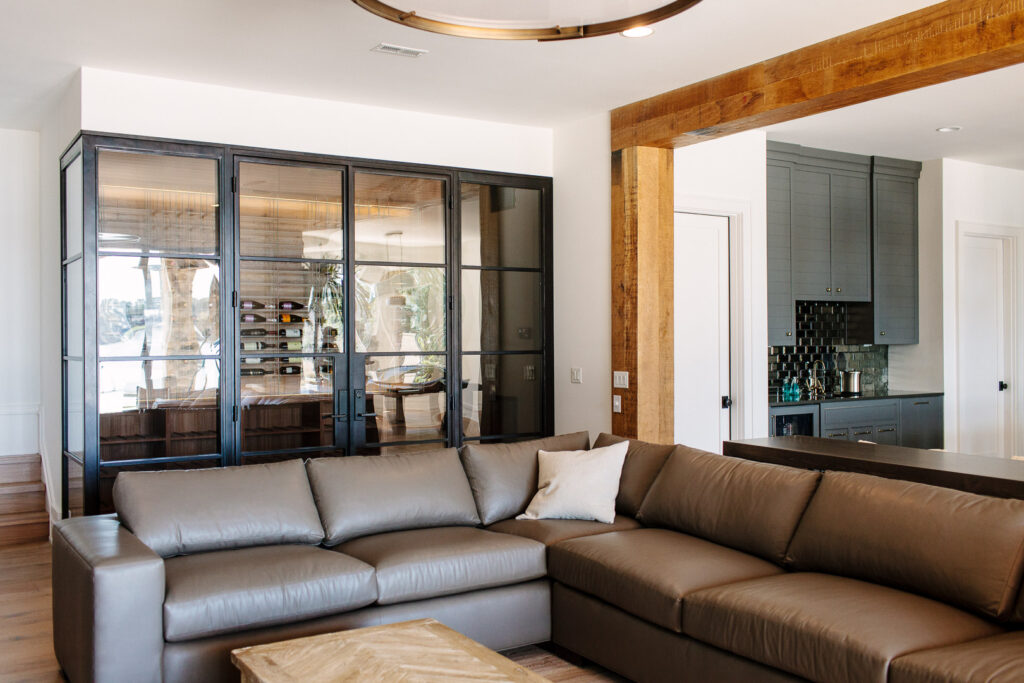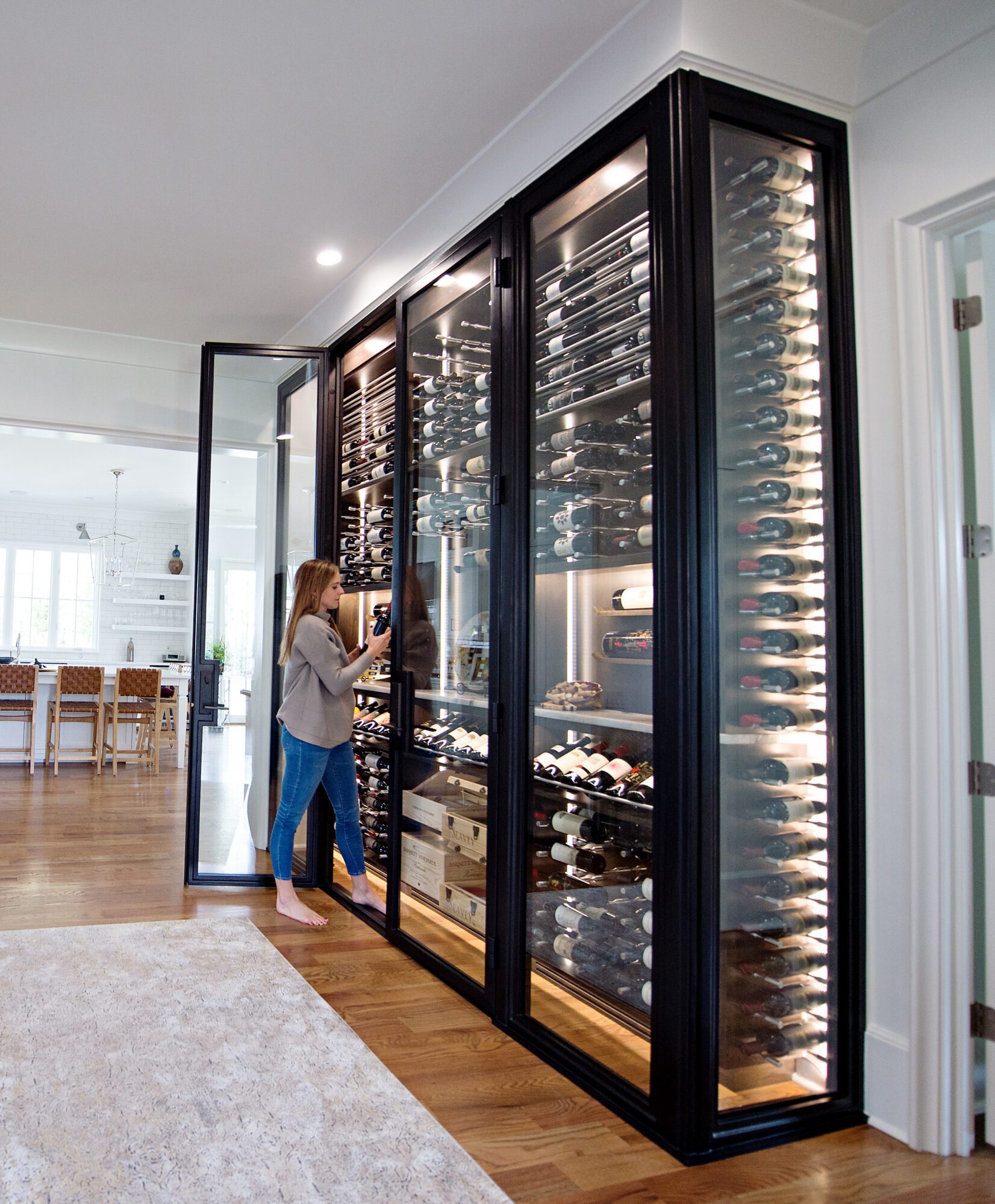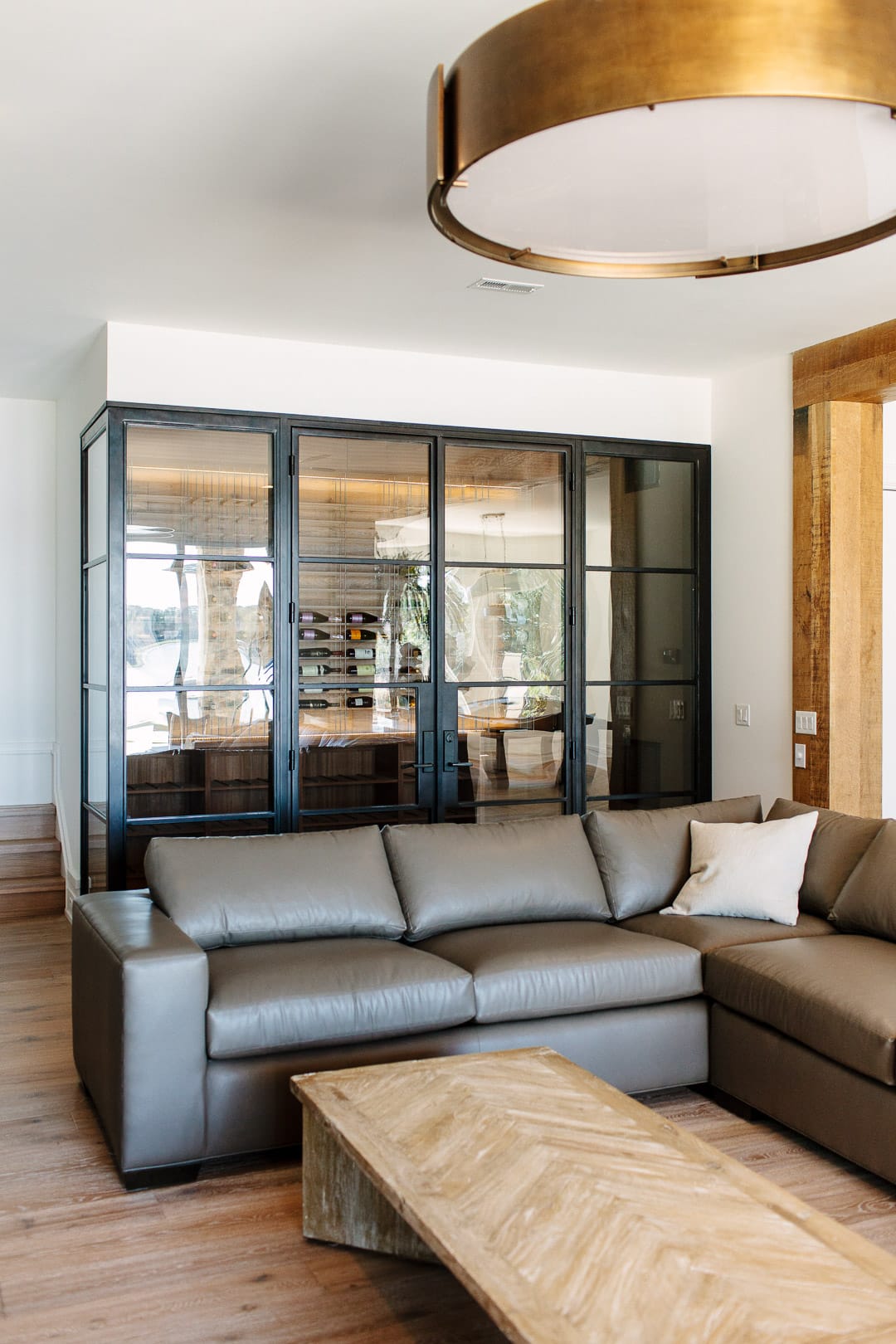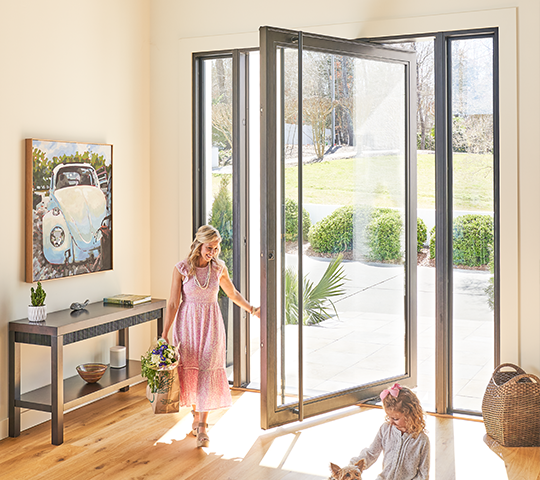Appreciating a fine wine doesn’t have to be reserved for your favorite restaurant. For centuries, wine enthusiasts have recognized the value of having a well-curated wine cellar at home — a space where prized bottles can age gracefully and be enjoyed at their peak.
At the heart of this experience is the wine cellar door. It’s the first impression, the reveal, and the moment that transforms a storage space into a destination worth stepping into.
At Clark Hall, we specialize in designing custom iron doors that bring your dream wine cellar to life. In this blog, we’ll explore our best-selling wine cellar door designs — from DIY kits and finishing options to specialized design modules that make your vision a reality.
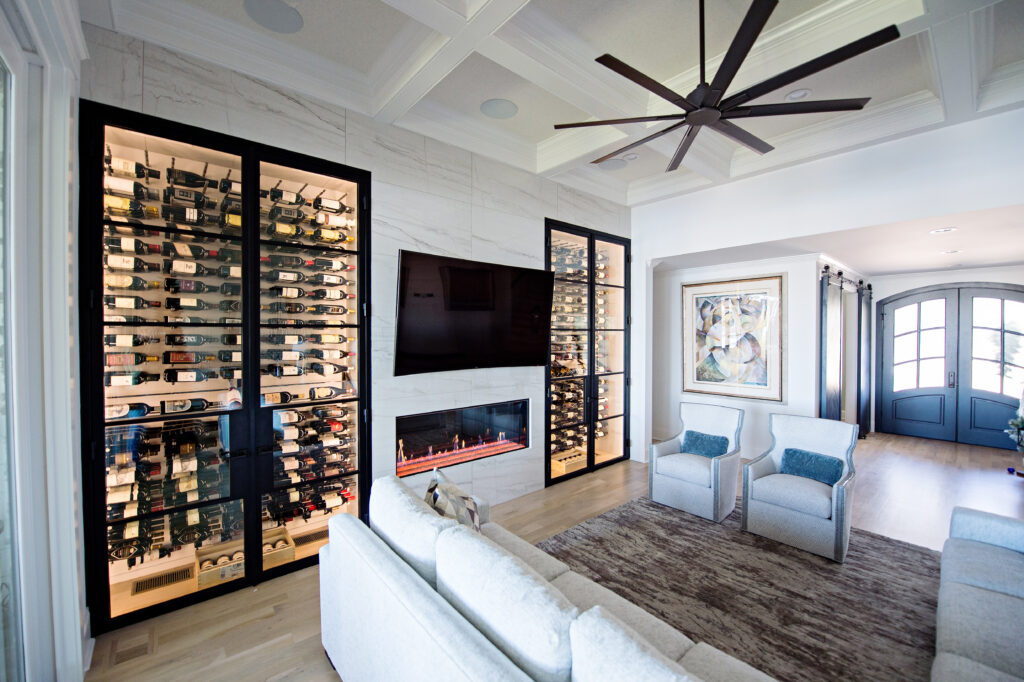
Benefits of a Custom Wine Cellar
Stunning statement piece aside, a custom wine cellar design holds several practical purposes. Namely, a cellar helps preserve your wine and increases your home’s value. It’s also a stunning way to display your collection, whether it’s a highly curated assortment of early 20th-century varietals or your local favorites.
Preserving Wine Quality
A cellar can be paramount to maintaining a wine’s freshness. Although lauded for their staying ability, wines can (and do) go bad if not kept in a dark and cool environment. Home wine cellars can help through temperature control that keeps the wine room at 55 degrees alongside humidity controls that keep the humidity levels in a safe zone.
Enhancing Home Aesthetics
Curating your collection with a beautiful wine cellar, particularly if it’s not tucked away in a basement, is one way to enhance the aesthetic of your home. You can tailor the space to suit your place from custom cellar doors to unique wine rack layouts.
Investment and Value Addition
According to Fixr, the investment range for the addition of a wine cellar is quite large — from $15,000 to $60,000. Yet, keep in mind, that this value add could increase your home’s worth up to 31%.
Planning Your Home Wine Cellar
This is where, as a homeowner, you get to have fun and explore wine cellar design ideas. Imagine the possibilities — from wine cellar lighting that sets the perfect ambience to wine cellar flooring that adds character and texture. Is it a light and airy area in the front hall of your house or a rustic underground cellar?
Choosing the Location
Selecting the right location is one of the most exciting parts of designing a custom wine cellar — one that allows for plenty of personalization. There are countless ways to add an element of surprise.
We love the idea of installing a wine cellar under a staircase, adding utility to a small or large space that often goes unnoticed. Or, placing a wine cellar near the kitchen pantry makes for easy wine pairings during dinner. If you’re an avid collector who loves to entertain friends, placing the wine cellar near living or dining areas allows you to showcase your collection with pride.
For a more discreet approach, consider a basement or spare bedroom conversion, which can offer the perfect environment for temperature and humidity control while maintaining a sense of privacy and sophistication.
Understanding the Wine Storage Conditions
If you have a basement, underground wine cellars are often considered best because they tend to stay cooler. However, a cellar can be above ground too, so long as it is away from excess vibration and light. Also consider what area will stay coolest in case of a power outage — after all, you don’t want spoilage.
Temperature, humidity, insulation, ventilation
Estimating Storage Capacity
Knowing how much wine you want to store is incredibly important in the planning process. You can store many bottles in a smaller cellar, though you won’t have as much room to display them all. For reference, a five-by-five room with nine-foot ceilings can hold approximately 500 bottles, per Wine Guardian.
Components of a Home Wine Cellar
Designing a home wine cellar may sound simple, but there are many components to consider, such as the lighting, a vapor barrier, cellar doors, and the storage system. We’ll go into detail on everything from tasting tables to cooling systems, so you can create a wine cellar that’s both beautiful and functional.
Below are some of the key elements to consider when planning your design:
- Tasting table: A dedicated surface for sampling and decanting that transforms your space into an intimate tasting room.
- Cooling and HVAC systems: Active refrigeration units or passive climate control maintain optimal temperature and humidity levels to protect your collection.
- Glass doors and windows: Create a stunning visual focal point while maintaining climate stability. Whether you prefer full-visibility glass or partial panes, these features offer an inviting glimpse into your collection.
- Label-forward display: Keep your favorite bottles front and center for both easy selection and elegant presentation.
- Humidifier, thermometer, and smart sensors: Enjoy peace of mind with 24/7 monitoring, alerting you to any temperature changes before they impact your wine.
- Security: From discreet locks to smart access control, security systems help safeguard your most valuable vintages.
Protective Finishes and Sealants
Even the most advanced cooling system can’t protect your wines if your cellar door isn’t properly sealed. High-quality finishes and sealants are essential to maintaining a consistent climate and preserving your collection over time.
At Clark Hall, our cellar doors undergo a seven-step, automotive-grade finishing process that ensures they maintain their appearance and functionality for years to come. Paired with precise weatherstripping, this finishing process creates a climate-controlled seal that stabilizes your cellar’s temperature and humidity levels.
The best part? Maintaining an iron door is refreshingly simple. It only requires a few annual wipe-downs with mild soap and water, plus occasional checks of seals and hardware.
Design Styles for Home Wine Cellars
Ideally, your wine cellar design style should mesh with your home’s overall aesthetic. By embracing one of the three main cellar types and making it your own, you can seamlessly craft a storage solution that works with your space rather than against it — here’s some inspiration:
Traditional
Not to be confused with rustic cellars, a traditional wine cellar includes some of the same elements. However, rather than a stone-hewn feel, the wood and rock styling in these spaces is more elevated with touches of luxury. You may see details like arched doorways or dark color schemes.
Modern
A modern wine cellar design encapsulates lots of ideas. Some are minimalistic with sleek metal flourishes and neutral tones while others incorporate unique lighting designs to modernize the space, which could easily fit near a dining room or kitchen. Often this style is defined by the modern look of elements such as light, color, and metal.
Rustic
A rustic wine cellar is probably going to most closely resemble a French une cave à vins — a wine cave. Think of lots of exposed stone, brickwork, or natural wood features. Rustic cellars can be made just as inviting as modern ones with warm lighting and antique accessories.
Mediterranean
Rooted in old-world charm, Mediterranean-style wine cellars combine timeless function with natural materials. Expect arched doorways, wrought iron detailing, and warm, earthy tones that evoke the feel of coastal villas. Like rustic styles, Mediterranean designs often showcase exposed stonework, but elevate it with decorative tile accents and rich wood finishes for a look that’s both welcoming and sophisticated.
Contemporary
Characterized by clean lines and an emphasis on sleek functionality, contemporary wine cellars let your wine cellar lighting ideas run wild. Strategic LED placements highlight prized bottles and create the illusion of expanded space, while frameless glass enclosures and minimalist shelving deliver an open, striking aesthetic.
Customizing Your Wine Cellar
Aside from the logistical elements you need for a wine cellar, customizations add a personal touch. For example, you could brighten the room with splashes of color or set the tone with accent furniture.
Incorporating Tasting Areas
Cultivate a homey wine storage space to entertain loved ones. Bring in seating and a table and incorporate artwork to make your tasting area. This way, you can sample your vino in comfort without leaving the serenity of your cellar.
Utilizing Decorative Elements
Even if your wines are not demurely displayed throughout the cellar, there are myriad ways to decorate the space. Aside from art, utilize accent lighting or aesthetically pleasing walls or floors to add character to the cellar.
Integrating Smart Technology
Wine cellars have been around for millennia, yet they continue to advance. Keep track of your wines through the CellarTracker app or change the mood with smart LED lights. Monitoring your storage has also never been easier thanks to The Elertus Wine Protection System which alerts your phone for things like movement and temperature or humidity changes.
Glass Enclosure
Transform your wine cellar into a stunning architectural feature that naturally draws the eye. A glass-enclosed design not only showcases your collection but also integrates it seamlessly into your house’s overall aesthetic. For a modern, gallery-like look, choose frameless glass panels that create a floating effect and enhance the sense of openness.
Lighting Design
Strategic lighting transforms a wine cellar from functional storage into a captivating experience. LED backlighting creates an alluring glow behind bottles and glass shelving. To add visual depth in small spaces, use under-shelf strips to illuminate each tier. You can even spotlight your most prized bottles, making them the star of the show.
Adding a Wine Cellar Door
Nothing completes the look of your wine cellar quite like the door. A wine cellar door is an opportunity to create a striking visual impact and showcase your collection. Iron doors with glass panels frame your bottles like a work of art while maintaining the climate control your wines need to age gracefully.
You can even customize them to fit your space — and all doors made by Clark Hall are custom-made. By incorporating double glass doors or any other wine cellar doors with glass, you can show off your collection while still keeping the bottles cool and comfortable. For instance, the wine cellar iron door from Clark Hall frames the collection in full view through stylish glass panels.
Clark Hall Wine Cellar Customizations
There is a lot to consider in creating a wine cellar. You can increase your home value and protect your beloved wines at the same time. As far as your gorgeous cellar entrance is concerned though, our professional designers are always available to lend a hand. Contact us with all of your wine cellar door needs, and together we can make your storage dreams a reality.
FAQs
What materials are best for DIY wine cellar racks?
When it comes to DIY wine cellar racks, the best materials are typically metal and wood. They each offer distinct advantages in both aesthetics and performance:
- Wood Racks – Bring a sense of classic warm and timeless charm to your wine cellar. When properly sealed, they’re highly durable and can be stained, painted, or finished to complement your cellar’s overall design.
- Metal Racks – Offer sleek lines and impressive durability with minimal maintenance. Metal wine racks are resistant to moisture damage, making them ideal for temperature-controlled environments.
Both wood and metal rack systems are available in DIY kits with flexible configurations, whether you prefer freestanding units or wall-mounted displays.
How do I choose between framed and frameless glass cellars?
Frameless glass cellars provide an unobstructed view and a sleek, modern aesthetic that showcases your wine collection as a floating display. However, installing a frameless glass cellar can be more complex and typically costs more. Framed glass is easier to install and offers better condensation control with integrated seals and weatherstripping. When deciding between frameless and framed glass, consider your budget and desired maintenance levels. Framed glass requires less maintenance and hides smudges, but doesn’t deliver the wow factor.
What finishing options are available for wine cellar iron doors?
At Clark Hall, each iron door undergoes a seven-step, automotive-grade finishing process designed to protect against moisture and wear. This ensures your door remains pristine as the day it’s installed. Choose from 13 signature finishes, including Gold Mist, Burnt Copper, Bronze, and Cinnamon, to create a look that perfectly complements your space. Pair your finish with precision weatherstripping for a reliable, airtight seal. Maintenance is simple — just a quick wipe-down with mild soap and water and occasional hardware checks will keep your iron cellar door performing beautifully for years.
How do I size a cooling unit for my cellar?
When sizing a cooling unit, calculate BTUs based on your cellar’s cubic footage, but factor in insulation quality, glass walls, and whether you’re against an exterior wall or a hot space. If you under-size, your wines could suffer, and if you over-size, it wastes energy and money. For the most accurate sizing, consult an HVAC specialist. They’ll account for your specific setup needs and climate conditions for the best results.
Can I install a wine cellar door myself?
While it’s possible to install a door in your own wine cellar, professional installation is strongly recommended. Custom iron doors are heavy, require precise alignment, and need specialized weatherstripping to maintain the cellar’s climate seal. Professional installation ensures your wine cellar door functions properly. DIY risks voiding warranties and compromising temperature control. Plus, depending on your location, permits for structural or electrical work may be required.
How much does it cost to build a home wine cellar?
It depends on the size and elements involved. However, a general estimate is between $15,000 and $60,000.
What are the ideal conditions for wine storage?
Wine is temperamental, so you want to store it in a dark, cool, and humidity-controlled space. The average ideal temperature for wine storage is 55 degrees with the humidity sitting right around 70%.
Can I build a wine cellar in a small space?
Absolutely! Even a tiny five-by-five room with a nine-foot ceiling is considered large enough to hold up to 500 bottles of wine. You’d be surprised how much you can do with a small wine cellar.
How do I maintain my wine cellar?
Ventilation and cleaning are both important elements of an ideal wine cellar environment. Ventilation to prevent mold and mildew, which can affect your wine and cleaning to keep debris out of the area.

